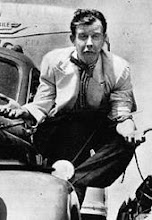I'm your huckleberry...
Howdy folks! Last weekend, the missus and I drove south through Bakersfield, all the way to beautiful Santa Clarita, California. There, on the site of former owner Gene Autry's Melody Ranch, was the 18th annual Santa Clarita Cowboy Festival. We went to spread the good word about SCGC, setting up a display of 5 guitars for festival attendees to try out.What made the festival unique was the setting itself: on the ranch stands an authentic old western movie set. The 1/4 mile long 'town' on Melody Ranch has been used in over 750 western films since 1916. The larger than life set is a wonderfully cliched image of the Old West built in vivid detail. Or is it simply cliched since we've seen it in so many westerns? Regardless, what brought the set to life were the people roaming up and down the street, dressed in full-on old west cowboy chic. These folks weren't foolin' about! The costumes were amazing! Many of the attendees have worked as movie extras. I met folks who had been extras in films such as Tombstone and TV shows such as Deadwood and Wild West Tech. At either end of the town were two stages where musicians including Don Edwards, The Hot Club of Cowtown, and The Sons of the San Joaquin performed. We also caught acts by cowboy poet, Waddie Mitchell and a spectacular trick gunslinger exhibition by Joey Dillon. Special care was taken to emphasize that the music at the festival was cowboy music, not just country. This was the original country music.
Ok... on with the photos! (click to enlarge)
view down main street, Saturday 11am. SCGC was set up in the third building on the right:






fiddler in the street:
 cowboy singer on horseback:
cowboy singer on horseback:









Hot Club of Cowtown performs:

The store fronts along main street were full of vendors selling everything from hand tooled leather gun belts, buck skin jackets, tacky cowboy art, custom made spurs, cowboy cook books and a whole lot more. I finally found a hat that fit my large melon:

The most recent addition to our company's stable of professional guitarists is legendary cowboy singer, Don Edwards. He and SCGC president, Richard hoover, collaborated to make a signature model guitar, honoring Don's 50th year in the entertainment business. Don headlined the festival and was a major attraction at the SCGC booth. Well, I should say his 6'5" cardboard like-age was a huge attraction. Here's a photo of a young fan at the SCGC booth:
 A photo of Don Edwards and me at the SCGC booth:
A photo of Don Edwards and me at the SCGC booth:
A Japanese gentleman who spoke broken English stopped to check out a few of our guitars and even sang a few old cowboy tunes for us:
 Shopping for wares in one of the many tent vendors on the outskirts of 'town':
Shopping for wares in one of the many tent vendors on the outskirts of 'town':

Me on day 2, having just picked up the Otis B. Rodeo horseshoe from the blacksmith across the street from us:
 It was a great time! The folks at the festival showed a lot of interest in the guitars we had on display and man oh man... what fun to be duded up and part of the fun in this over the top weekend! We're already looking forward to next year.
It was a great time! The folks at the festival showed a lot of interest in the guitars we had on display and man oh man... what fun to be duded up and part of the fun in this over the top weekend! We're already looking forward to next year.





























